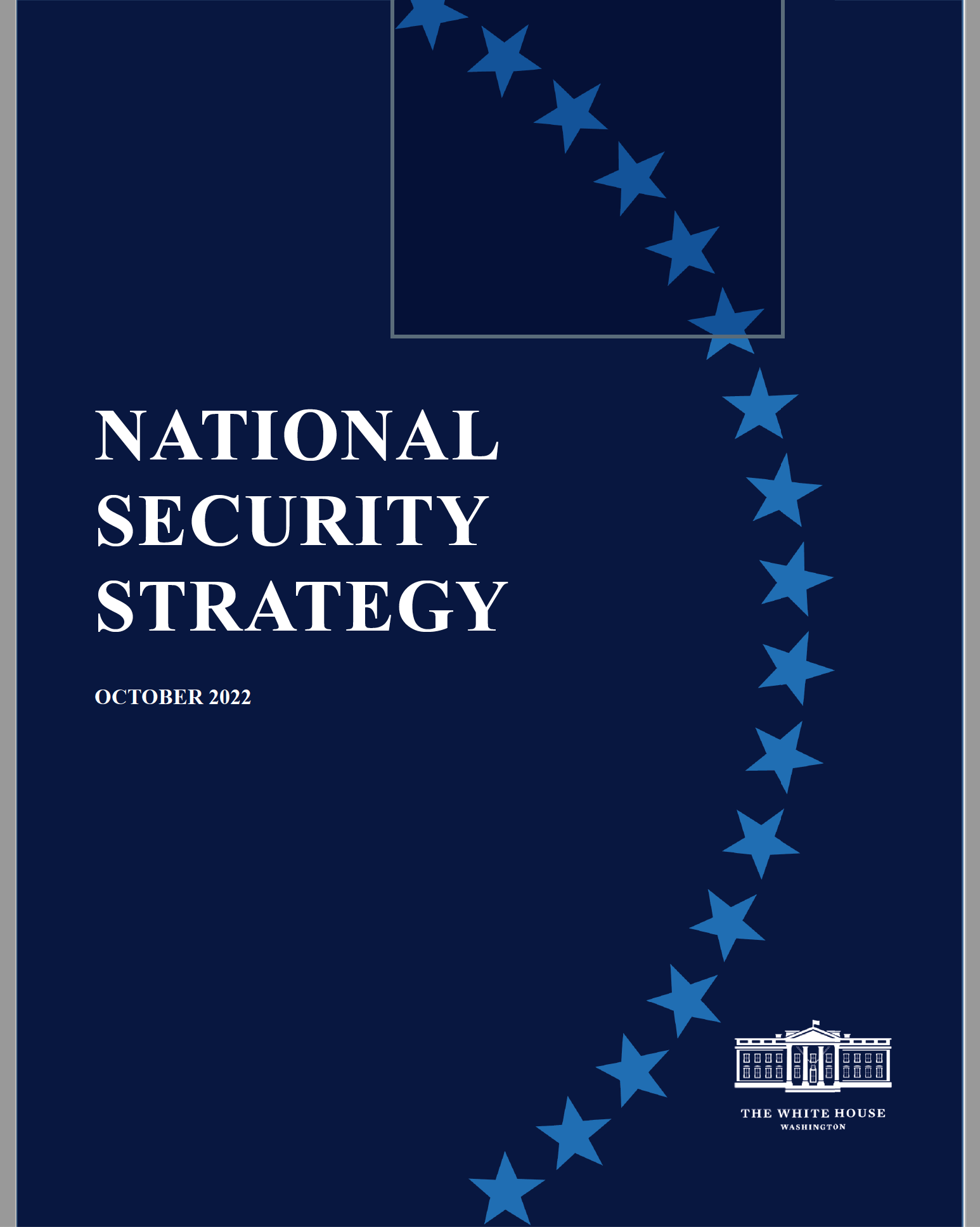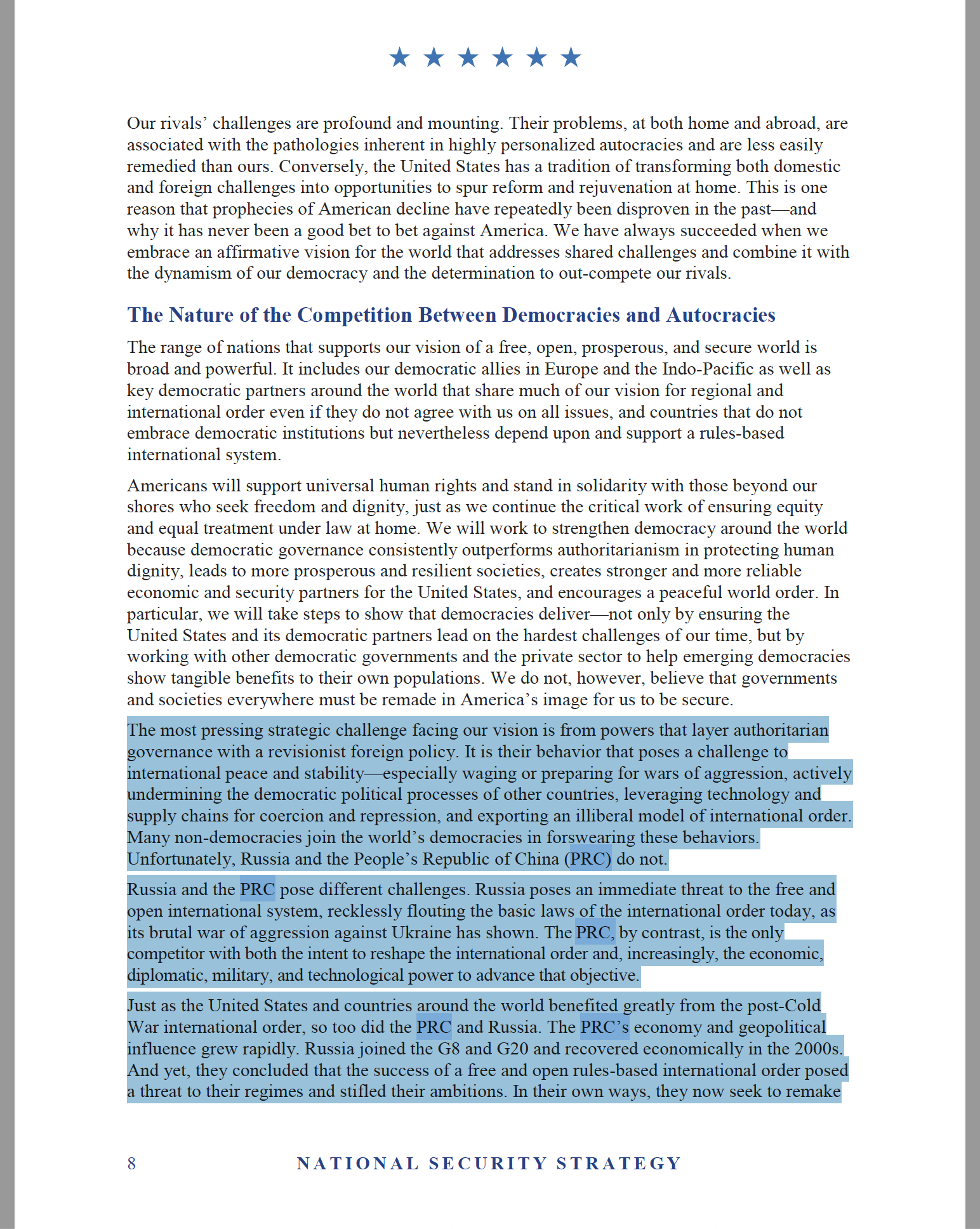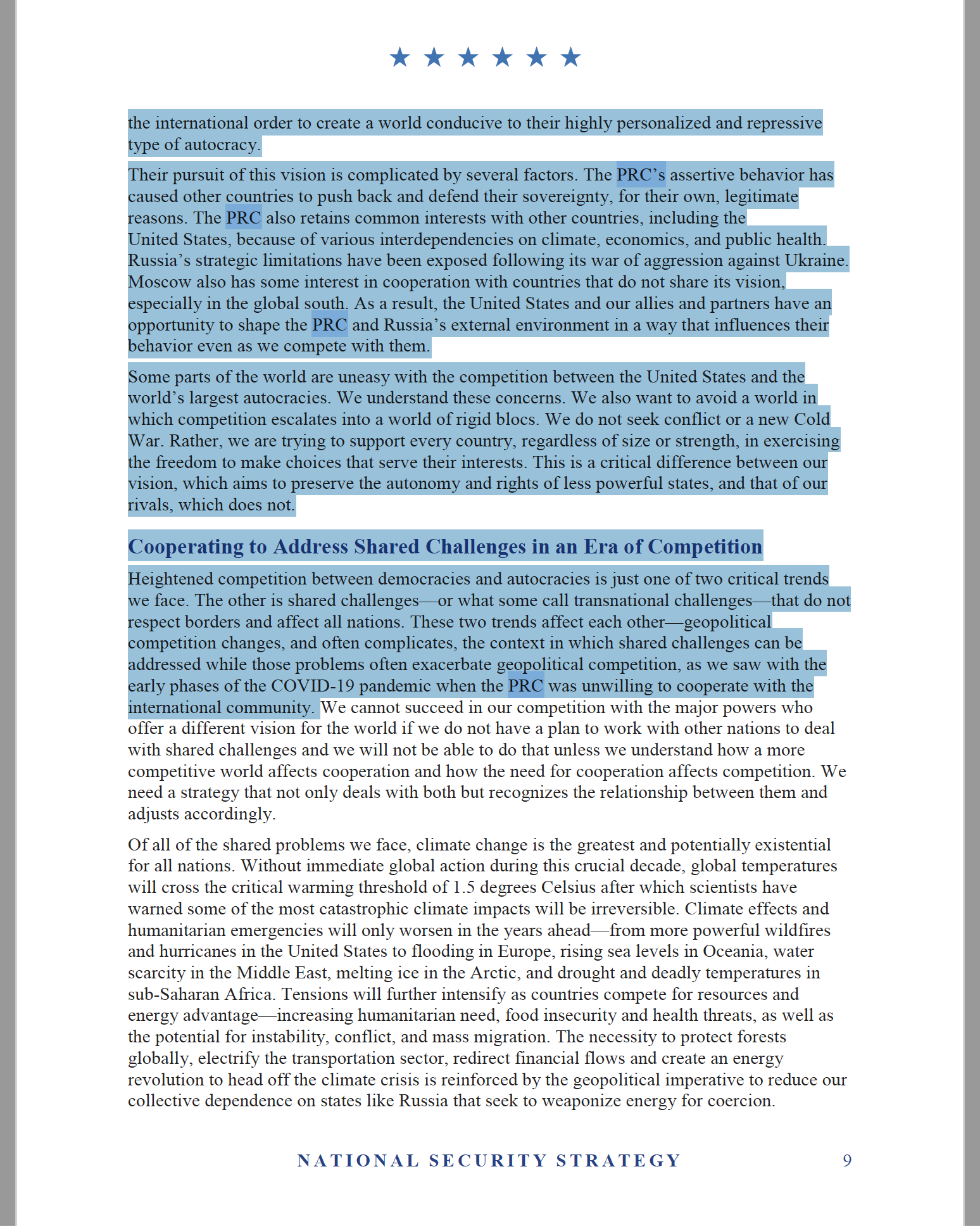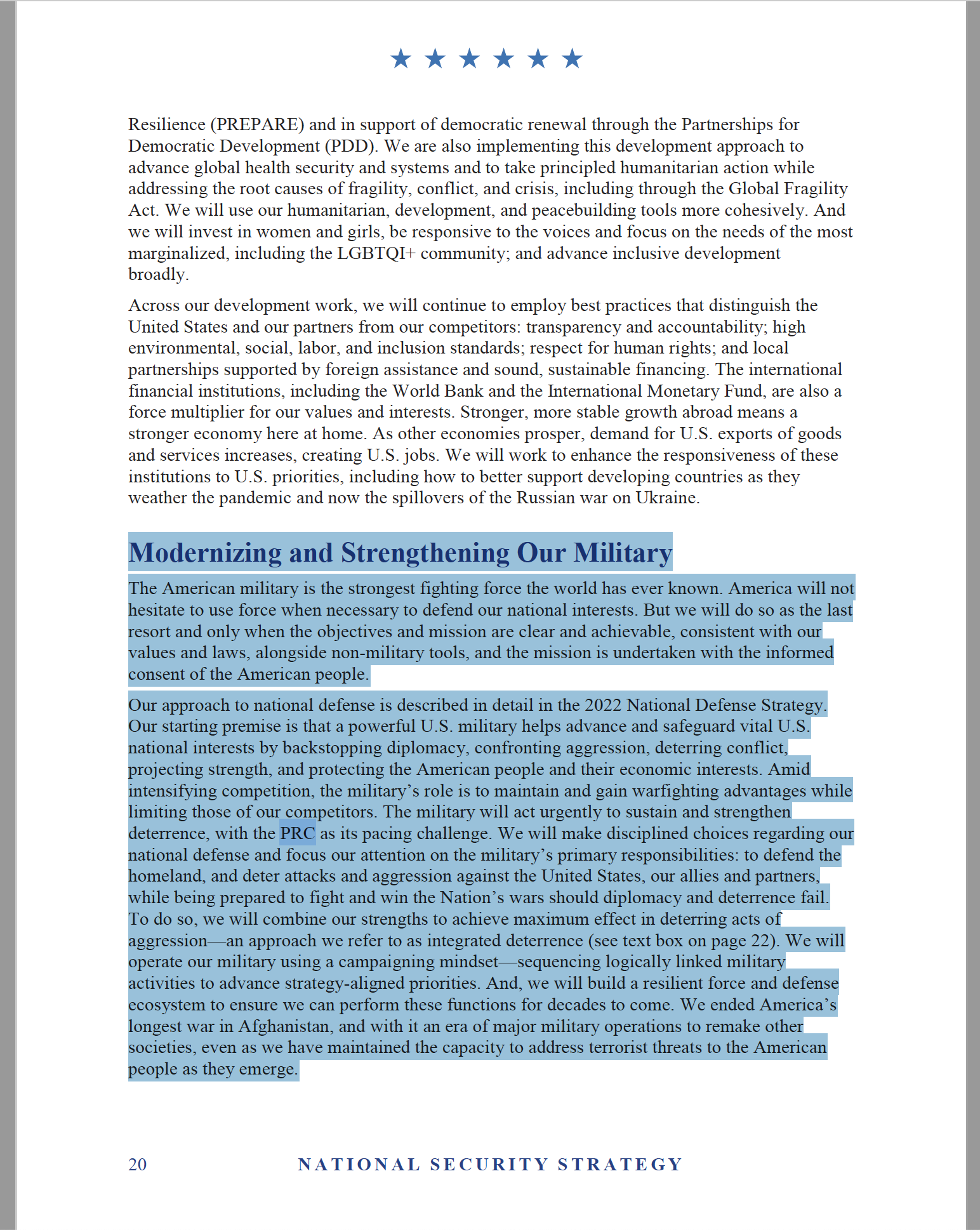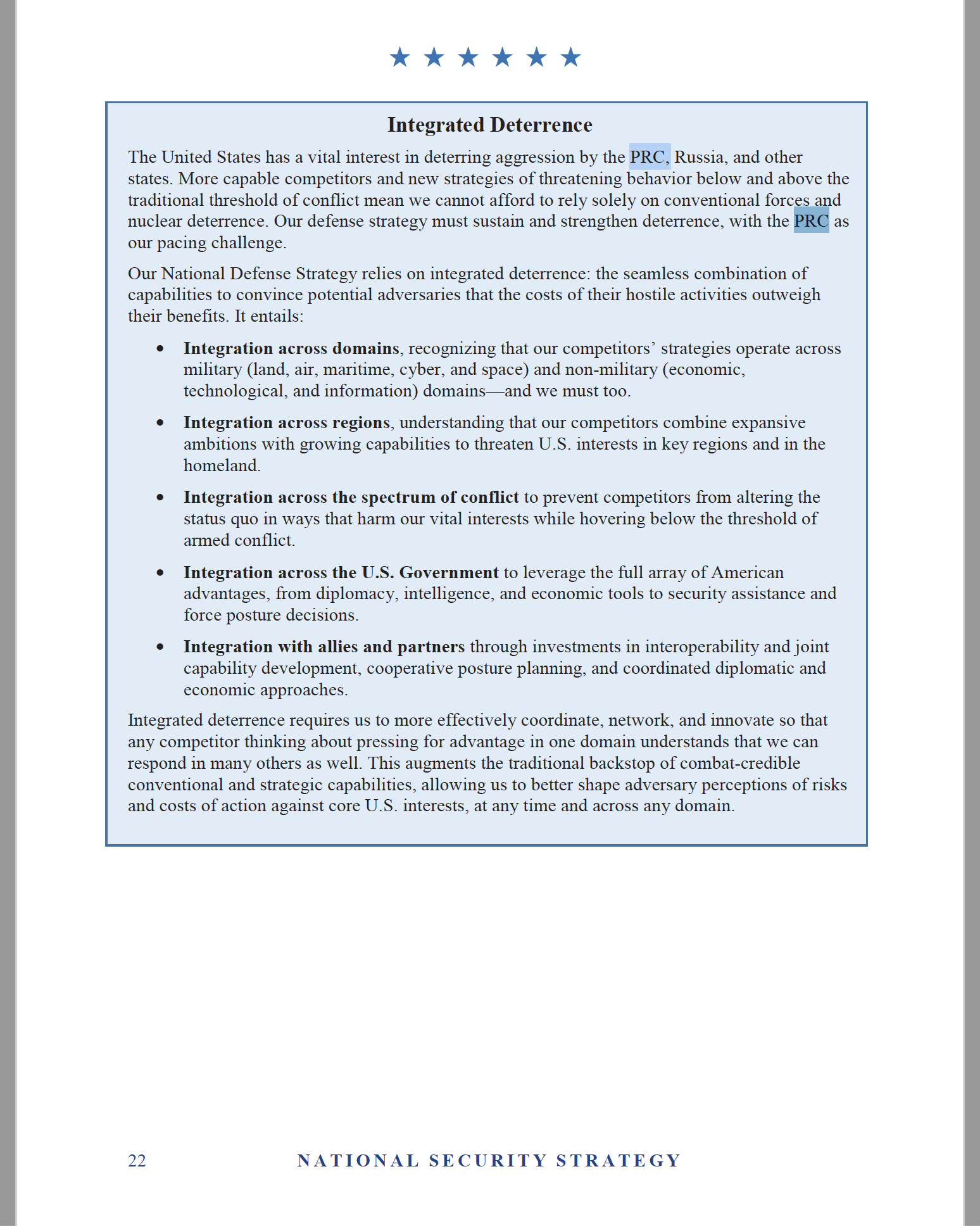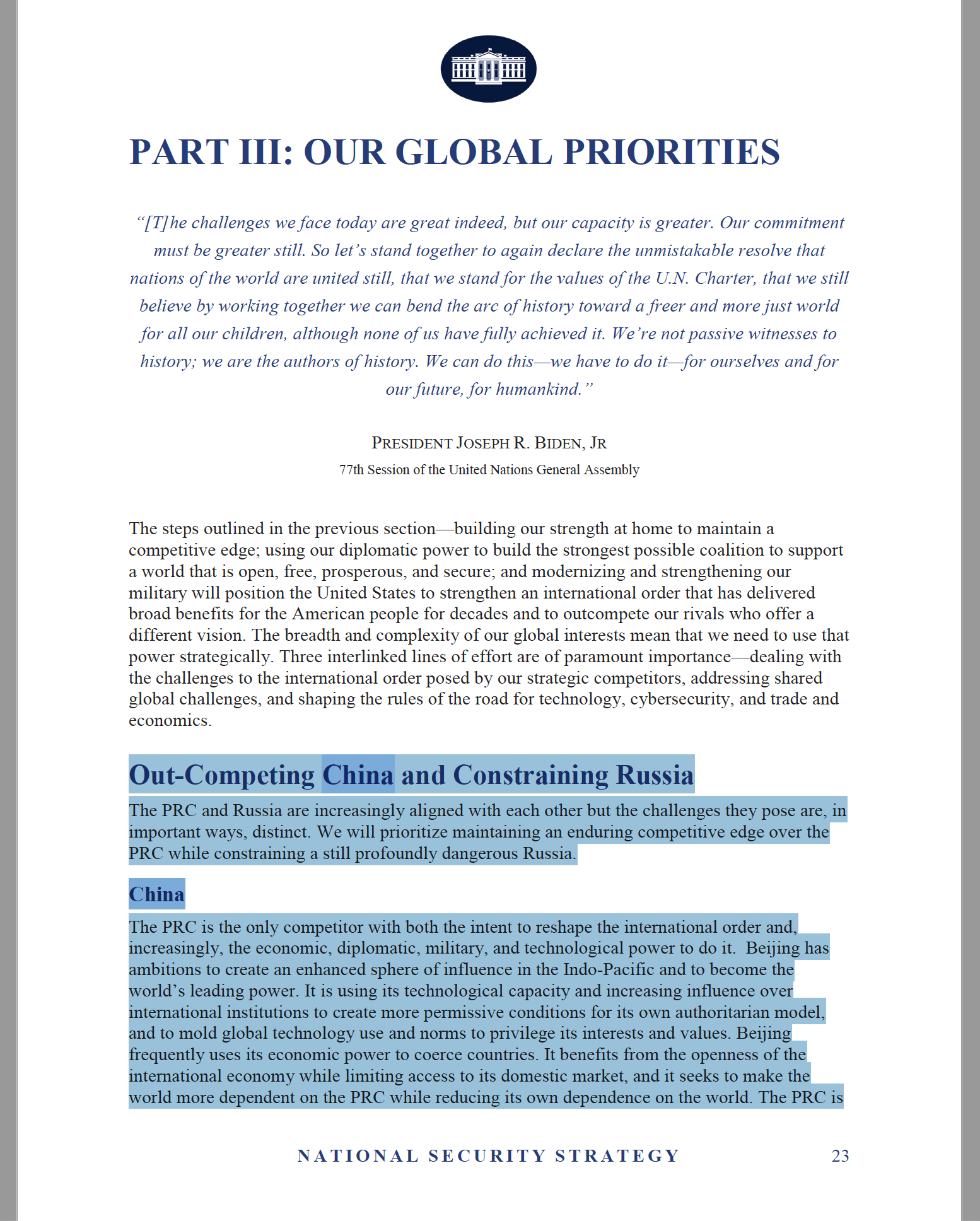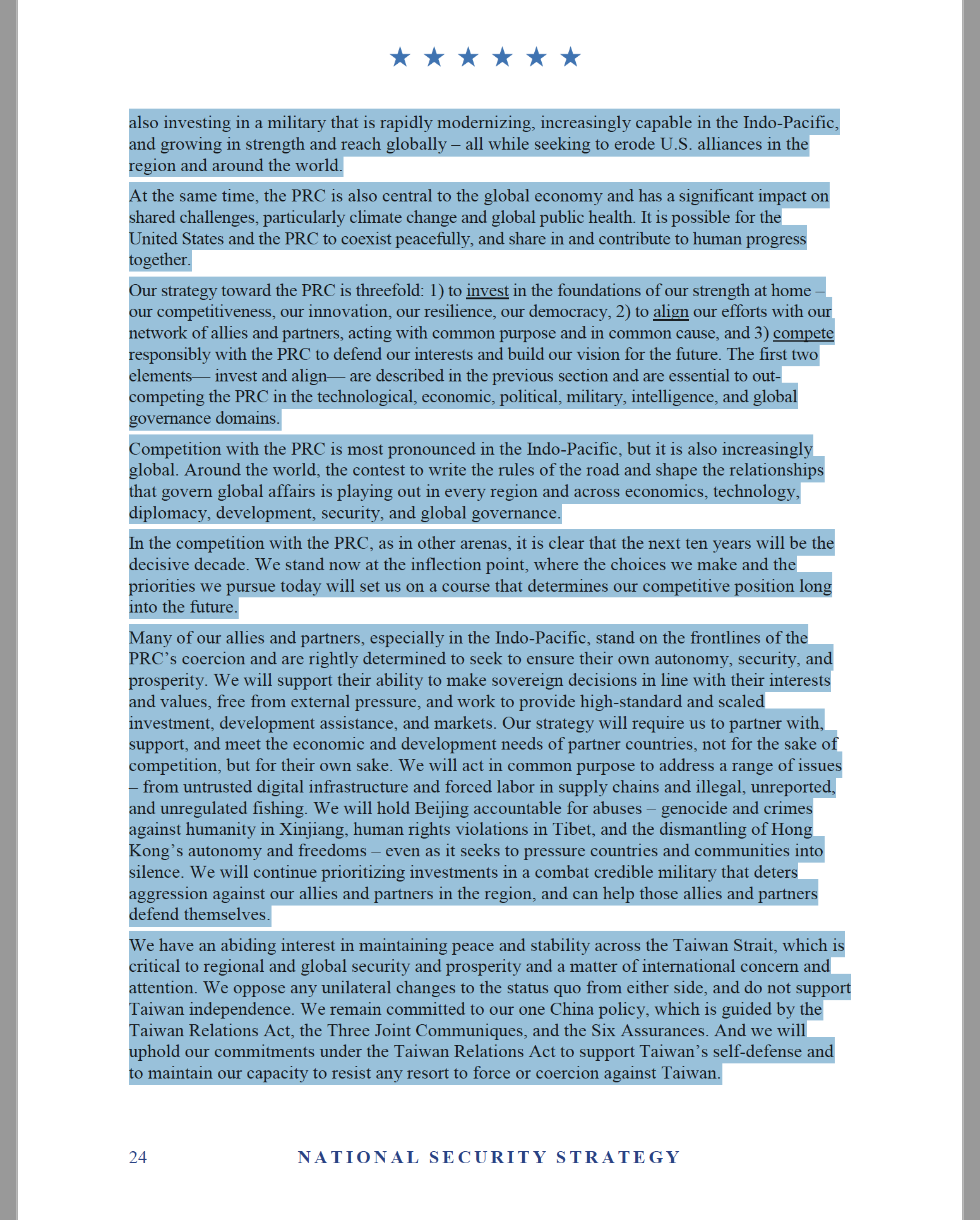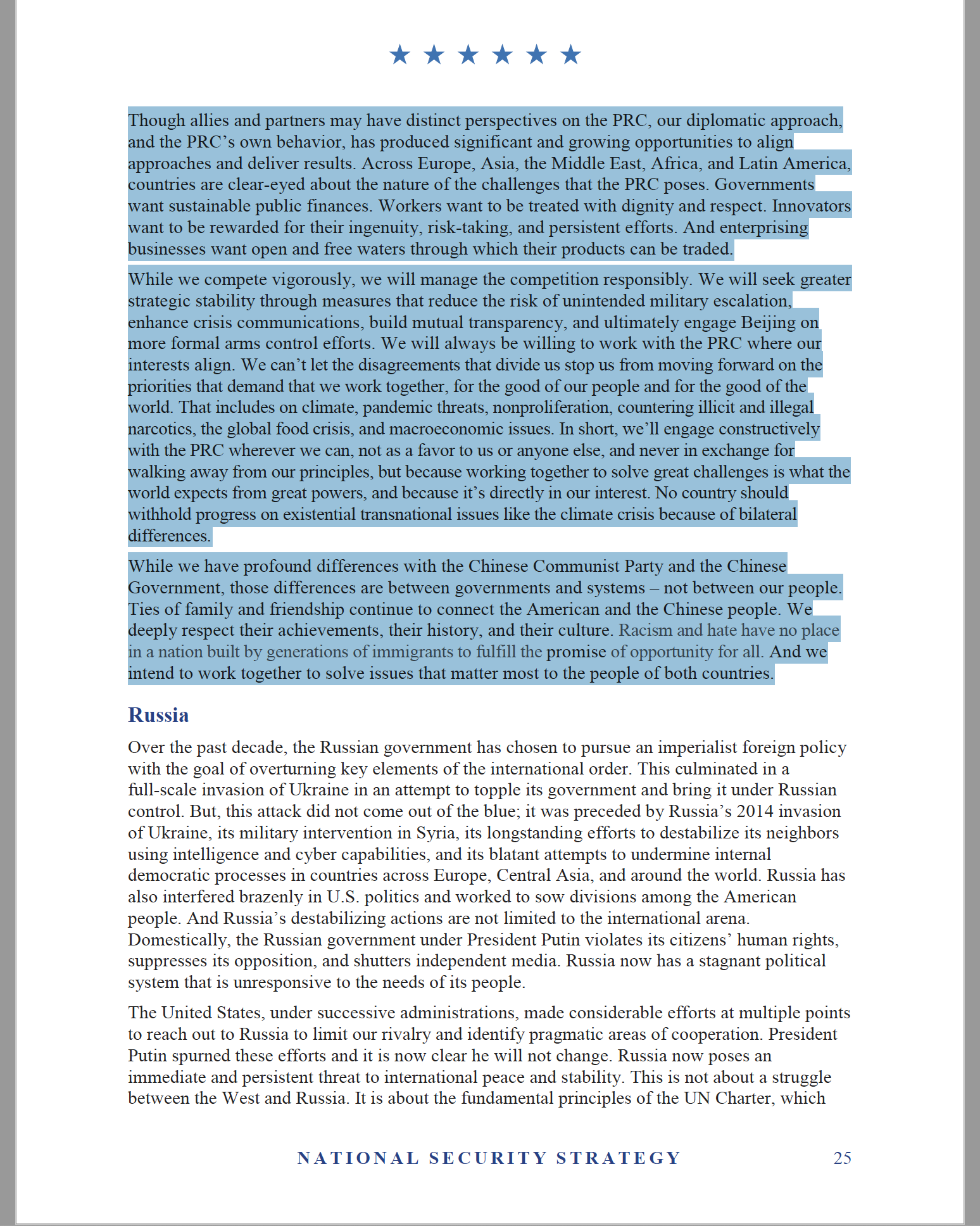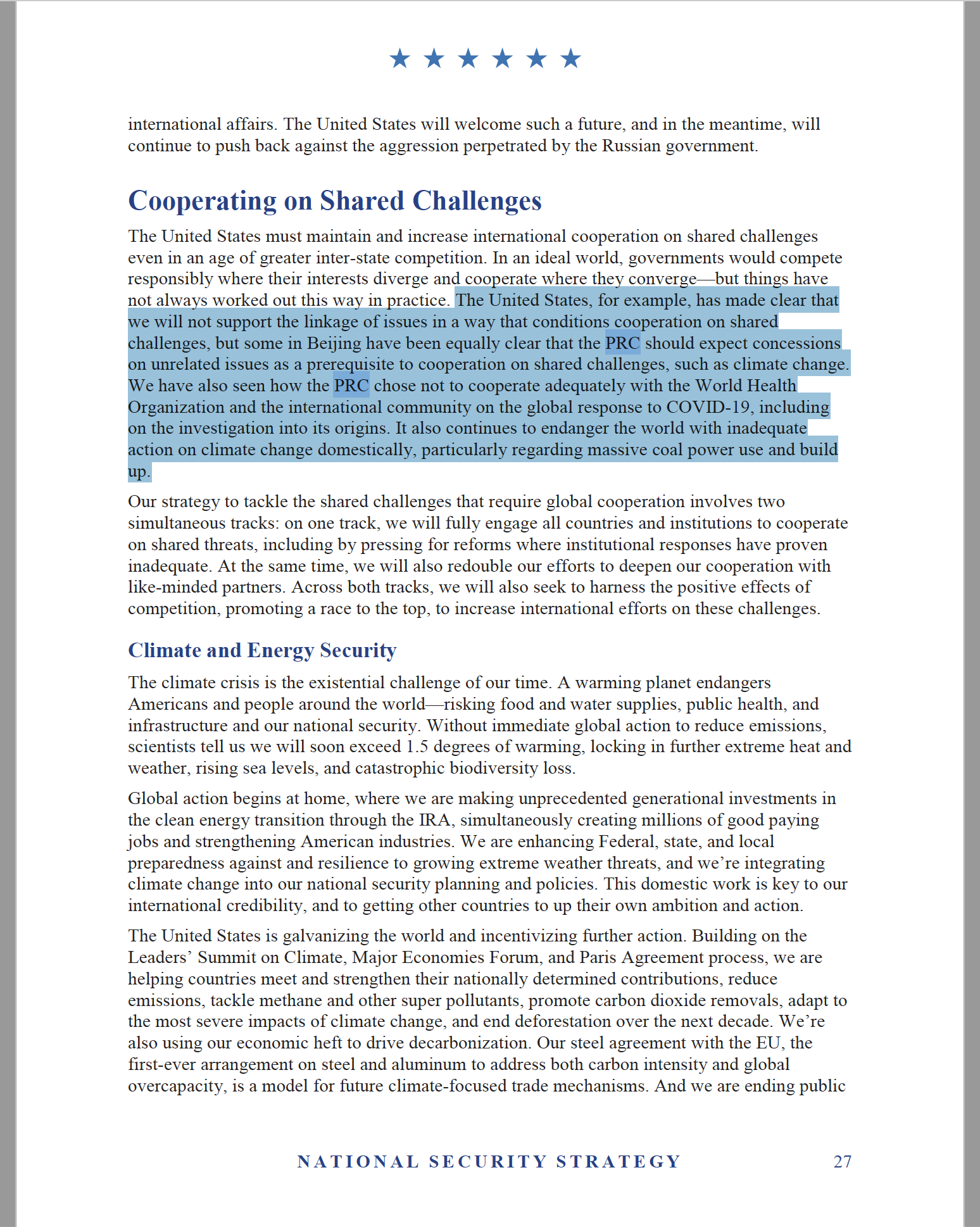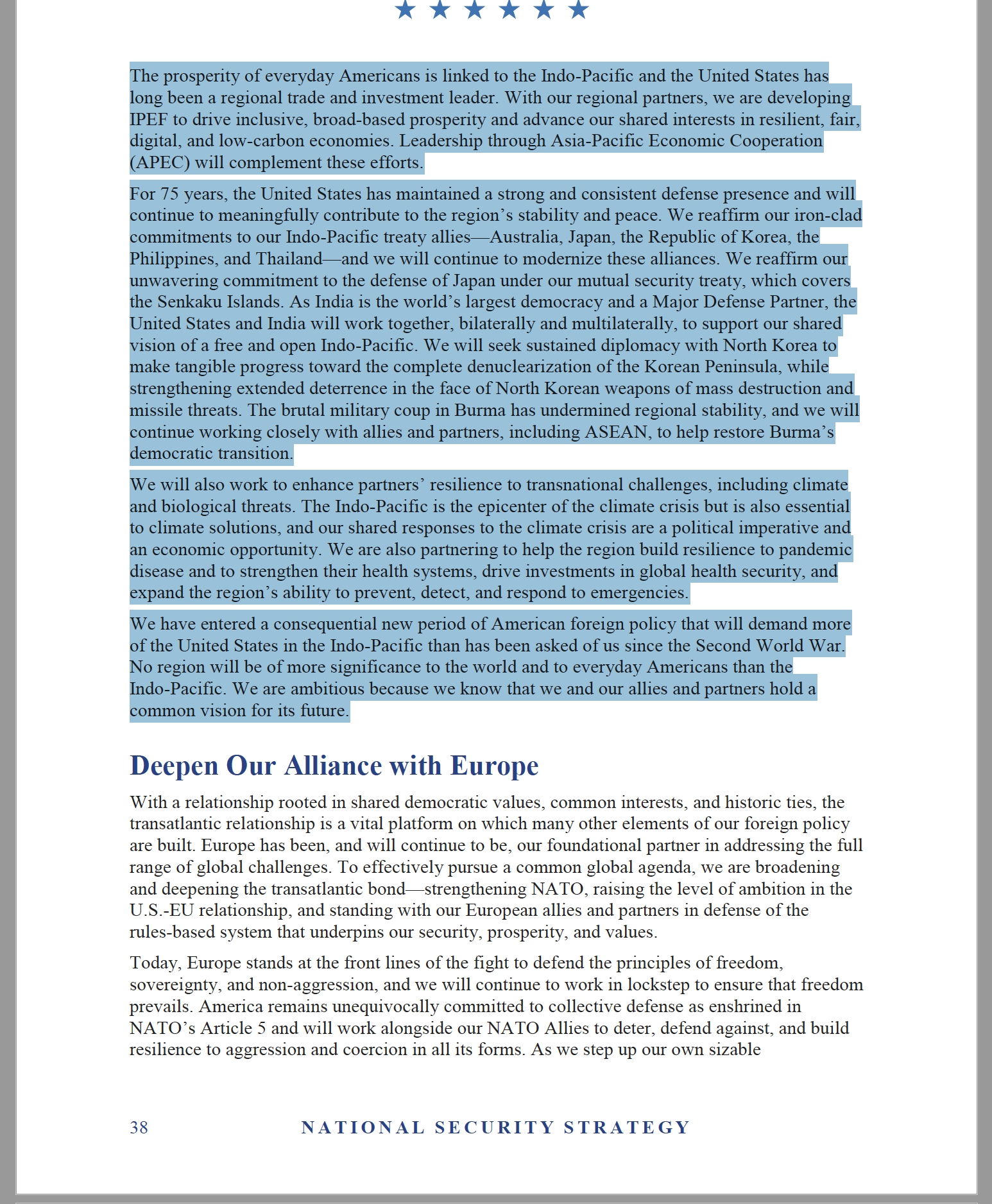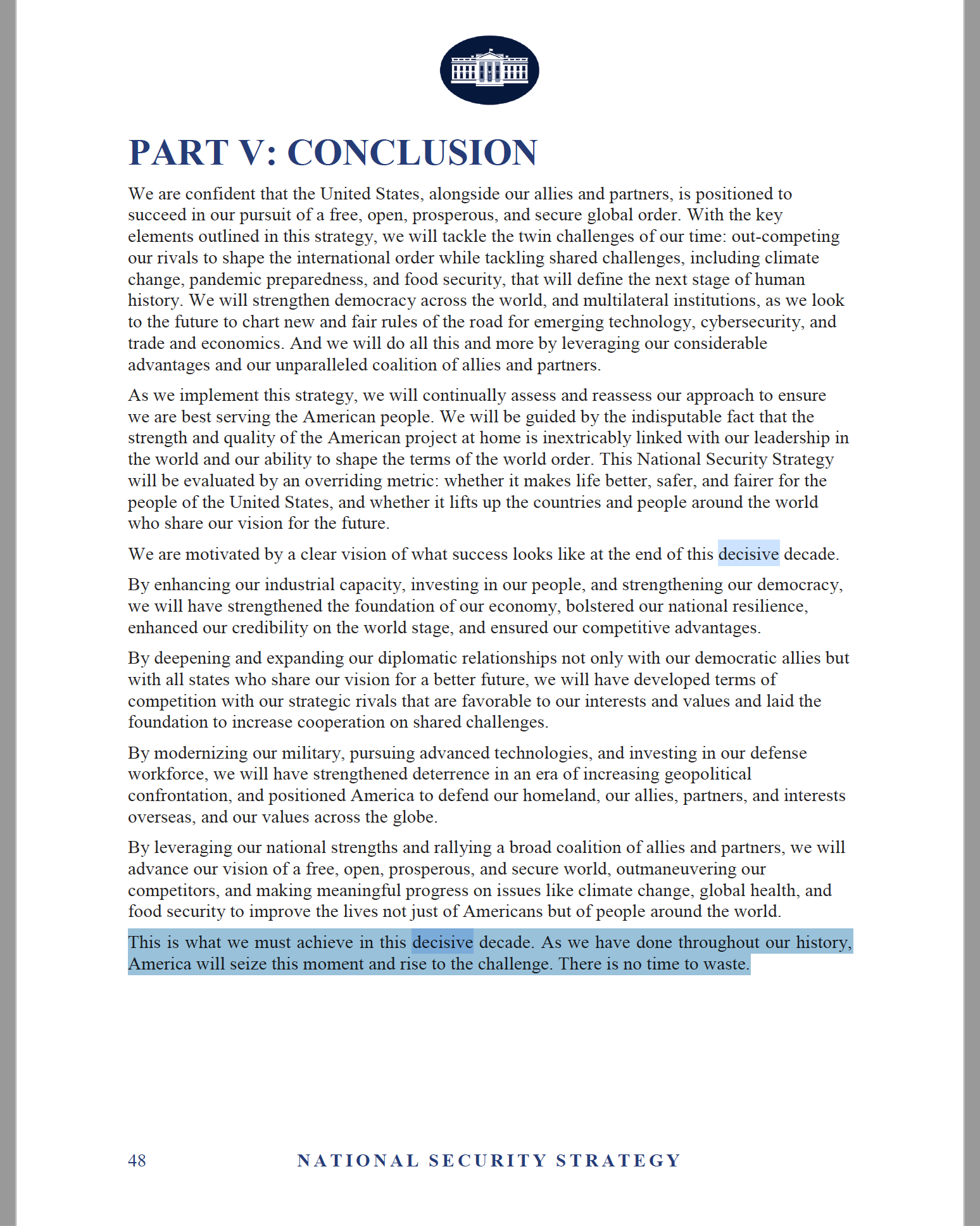New U.S. National Security Strategy: Key China Content
The People’s Republic of China harbors the intention and, increasingly, the capacity to reshape the international order in favor of one that tilts the global playing field to its benefit, even as the United States remains committed to managing the competition between our countries responsibly.
p. 6
Our Enduring Vision
We are now in the early years of a decisive decade for America and the world. The terms of geopolitical competition between the major powers will be set. The window of opportunity to deal with shared threats, like climate change, will narrow drastically. The actions we take now will shape whether this period is known as an age of conflict and discord or the beginning of a more stable and prosperous future.
p. 8
The most pressing strategic challenge facing our vision is from powers that layer authoritarian governance with a revisionist foreign policy. It is their behavior that poses a challenge to international peace and stability—especially waging or preparing for wars of aggression, actively undermining the democratic political processes of other countries, leveraging technology and supply chains for coercion and repression, and exporting an illiberal model of international order. Many non-democracies join the world’s democracies in forswearing these behaviors. Unfortunately, Russia and the People’s Republic of China (PRC) do not.
Russia and the PRC pose different challenges. Russia poses an immediate threat to the free and open international system, recklessly flouting the basic laws of the international order today, as its brutal war of aggression against Ukraine has shown. The PRC, by contrast, is the only competitor with both the intent to reshape the international order and, increasingly, the economic, diplomatic, military, and technological power to advance that objective.
Just as the United States and countries around the world benefited greatly from the post-Cold War international order, so too did the PRC and Russia. The PRC’s economy and geopolitical influence grew rapidly. Russia joined the G8 and G20 and recovered economically in the 2000s. And yet, they concluded that the success of a free and open rules-based international order posed a threat to their regimes and stifled their ambitions. In their own ways, they now seek to remake
p. 9
the international order to create a world conducive to their highly personalized and repressive type of autocracy.
Their pursuit of this vision is complicated by several factors. The PRC’s assertive behavior has caused other countries to push back and defend their sovereignty, for their own, legitimate reasons. The PRC also retains common interests with other countries, including the United States, because of various interdependencies on climate, economics, and public health.
Russia’s strategic limitations have been exposed following its war of aggression against Ukraine. Moscow also has some interest in cooperation with countries that do not share its vision, especially in the global south. As a result, the United States and our allies and partners have an opportunity to shape the PRC and Russia’s external environment in a way that influences their behavior even as we compete with them.
Some parts of the world are uneasy with the competition between the United States and the world’s largest autocracies. We understand these concerns. We also want to avoid a world in which competition escalates into a world of rigid blocs. We do not seek conflict or a new Cold War. Rather, we are trying to support every country, regardless of size or strength, in exercising the freedom to make choices that serve their interests. This is a critical difference between our vision, which aims to preserve the autonomy and rights of less powerful states, and that of our rivals, which does not.
Cooperating to Address Shared Challenges in an Era of Competition
Heightened competition between democracies and autocracies is just one of two critical trends we face. The other is shared challenges—or what some call transnational challenges—that do not respect borders and affect all nations. These two trends affect each other—geopolitical competition changes, and often complicates, the context in which shared challenges can be addressed while those problems often exacerbate geopolitical competition, as we saw with the early phases of the COVID-19 pandemic when the PRC was unwilling to cooperate with the international community.
p. 11
Third, this strategy recognizes that the PRC presents America’s most consequential geopolitical challenge. Although the Indo-Pacific is where its outcomes will be most acutely shaped, there are significant global dimensions to this challenge. Russia poses an immediate and ongoing threat to the regional security order in Europe and it is a source of disruption and instability globally but it lacks the across the spectrum capabilities of the PRC.
p. 12
Fifth, we recognize that globalization has delivered immense benefits for the United States and the world but an adjustment is now required to cope with dramatic global changes such as widening inequality within and among countries, the PRC’s emergence as both our most consequential competitor and one of our largest trading partners, and emerging technologies that fall outside the bounds of existing rules and regulations. We have an affirmative agenda for the global economy to seize the full range of economic benefits of the 21st century while advancing the interests of American workers. Recognizing we have to move beyond traditional Free Trade Agreements, we are charting new economic arrangements to deepen economic engagement with our partners, like the Indo-Pacific Economic Framework for Prosperity (IPEF); a global minimum tax that ensures corporations pay their fair share of tax wherever they are based in the world; the Partnership for Global Investment and Infrastructure (PGII) to help low- and middle-income countries secure high-standard investment for critical infrastructure; updated rules of the road for technology, cyberspace, trade, and economics; and ensuring the transition to clean energy unlocks economic opportunities and good jobs around the world. … …
The world is now at an inflection point. This decade will be decisive, in setting the terms of our competition with the PRC, managing the acute threat posed by Russia, and in our efforts to deal
p. 13
with shared challenges, particularly climate change, pandemics, and economic turbulence. If we do not act with urgency and creativity, our window of opportunity to shape the future of international order and tackle shared challenges will close. Those actions must begin with developing the means to execute our strategy, by making renewed investments at home and abroad.
p. 14
Implementing a Modern Industrial and Innovation Strategy
The private sector and open markets have been, and continue to be, a vital source of our national strength and a key driver of innovation. However, markets alone cannot respond to the rapid pace of technological change, global supply disruptions, nonmarket abuses by the PRC and other actors, or the deepening climate crisis. Strategic public investment is the backbone of a strong industrial and innovation base in the 21st century global economy.
p. 17
America’s alliances and partnerships have played a critical role in our national security policy for eight decades, and must be deepened and modernized to do so into the future. NATO has responded with unity and strength to deter further Russian aggression in Europe, even as NATO also adopted a broad new agenda at the 2022 Madrid Summit to address systemic challenges from the PRC and other security risks from cyber to climate, as well as agreeing to Finland and Sweden’s application to join the alliance. The newly established U.S.-EU Trade and Technology Council is coordinating approaches to setting the rules of the road on global technology, economic, and trade issues based on shared democratic values. Our AUKUS security partnership with Australia and the United Kingdom promotes stability in the Indo-Pacific while deepening defense and technology integration. We continue to deepen cooperation with the Five Eyes (with Australia, Canada, New Zealand, and the United Kingdom). The revitalized Quad, which brings the United States together with Japan, India, and Australia, addresses regional challenges and has demonstrated its ability to deliver for the Indo-Pacific, combating COVID-19 and climate change, to deepening cybersecurity partnerships and promoting high standards for infrastructure and health security. Our intelligence relationships with our allies are a strategic asset that will increasingly factor in to our competition with our rivals, especially in technological competition.
We will continue to prioritize seeking out new ways to integrate our alliances in the Indo-Pacific and Europe and develop new and deeper means of cooperation. We have revitalized the G7 as the steering committee of the world’s advanced industrial democracies and believe it has a critical role to play in supporting our shared vision for the international order. The G7 is at its strongest when it also formally engages other countries with aligned goals, such as at the 2022 summit where Argentina, India, Indonesia, Senegal, South Africa, and Ukraine also participated. U.S. interests are best served when our European allies and partners play an active role in the Indo-Pacific, including in supporting freedom of navigation and maintaining peace and stability across the Taiwan Strait. Similarly, we want our Indo-Pacific allies to be engaged cooperatively with our European allies on shaping the order to which we all aspire, and by standing up to Russia and cooperating with the European Union and United Kingdom on our competition with the PRC. This is not a favor to the United States. Our allies recognize that a collapse of the international order in one region will ultimately endanger it in others.
p. 20
Modernizing and Strengthening Our Military
The American military is the strongest fighting force the world has ever known. America will not hesitate to use force when necessary to defend our national interests. But we will do so as the last resort and only when the objectives and mission are clear and achievable, consistent with our values and laws, alongside non-military tools, and the mission is undertaken with the informed consent of the American people.
Our approach to national defense is described in detail in the 2022 National Defense Strategy. Our starting premise is that a powerful U.S. military helps advance and safeguard vital U.S. national interests by backstopping diplomacy, confronting aggression, deterring conflict, projecting strength, and protecting the American people and their economic interests. Amid intensifying competition, the military’s role is to maintain and gain warfighting advantages while limiting those of our competitors. The military will act urgently to sustain and strengthen deterrence, with the PRC as its pacing challenge. We will make disciplined choices regarding our national defense and focus our attention on the military’s primary responsibilities: to defend the homeland, and deter attacks and aggression against the United States, our allies and partners, while being prepared to fight and win the Nation’s wars should diplomacy and deterrence fail. To do so, we will combine our strengths to achieve maximum effect in deterring acts of aggression—an approach we refer to as integrated deterrence (see text box on page 22). We will operate our military using a campaigning mindset—sequencing logically linked military activities to advance strategy-aligned priorities. And, we will build a resilient force and defense ecosystem to ensure we can perform these functions for decades to come. We ended America’s longest war in Afghanistan, and with it an era of major military operations to remake other societies, even as we have maintained the capacity to address terrorist threats to the American people as they emerge.
p. 21
Nuclear deterrence remains a top priority for the Nation and foundational to integrated deterrence. A safe, secure, and effective nuclear force undergirds our defense priorities by deterring strategic attacks, assuring allies and partners, and allowing us to achieve our objectives if deterrence fails. Our competitors and potential adversaries are investing heavily in new nuclear weapons. By the 2030s, the United States for the first time will need to deter two major nuclear powers, each of whom will field modern and diverse global and regional nuclear forces. To ensure our nuclear deterrent remains responsive to the threats we face, we are modernizing the nuclear Triad, nuclear command, control, and communications, and our nuclear weapons infrastructure, as well as strengthening our extended deterrence commitments to our Allies. We remain equally committed to reducing the risks of nuclear war. This includes taking further steps to reduce the role of nuclear weapons in our strategy and pursuing realistic goals for mutual, verifiable arms control, which contribute to our deterrence strategy and strengthen the global non-proliferation regime.
p. 22
Integrated Deterrence
The United States has a vital interest in deterring aggression by the PRC, Russia, and other states. More capable competitors and new strategies of threatening behavior below and above the traditional threshold of conflict mean we cannot afford to rely solely on conventional forces and nuclear deterrence. Our defense strategy must sustain and strengthen deterrence, with the PRC as our pacing challenge.
p. 23
PART III: OUR GLOBAL PRIORITIES…………………………………………………………………………. 23
Out-Competing China and Constraining Russia …………………………………………………………….. 23
China…………………………………………………………………………………………………………………….. 23
Out-Competing China and Constraining Russia
The PRC and Russia are increasingly aligned with each other but the challenges they pose are, in important ways, distinct. We will prioritize maintaining an enduring competitive edge over the PRC while constraining a still profoundly dangerous Russia.
China
The PRC is the only competitor with both the intent to reshape the international order and, increasingly, the economic, diplomatic, military, and technological power to do it. Beijing has ambitions to create an enhanced sphere of influence in the Indo-Pacific and to become the world’s leading power. It is using its technological capacity and increasing influence over international institutions to create more permissive conditions for its own authoritarian model, and to mold global technology use and norms to privilege its interests and values. Beijing frequently uses its economic power to coerce countries. It benefits from the openness of the international economy while limiting access to its domestic market, and it seeks to make the world more dependent on the PRC while reducing its own dependence on the world. The PRC is
p. 24
also investing in a military that is rapidly modernizing, increasingly capable in the Indo-Pacific, and growing in strength and reach globally – all while seeking to erode U.S. alliances in the region and around the world.
At the same time, the PRC is also central to the global economy and has a significant impact on shared challenges, particularly climate change and global public health. It is possible for the United States and the PRC to coexist peacefully, and share in and contribute to human progress together.
Our strategy toward the PRC is threefold: 1) to invest in the foundations of our strength at home – our competitiveness, our innovation, our resilience, our democracy, 2) to align our efforts with our network of allies and partners, acting with common purpose and in common cause, and 3) compete responsibly with the PRC to defend our interests and build our vision for the future. The first two elements— invest and align— are described in the previous section and are essential to outcompeting the PRC in the technological, economic, political, military, intelligence, and global governance domains.
Competition with the PRC is most pronounced in the Indo-Pacific, but it is also increasingly global. Around the world, the contest to write the rules of the road and shape the relationships that govern global affairs is playing out in every region and across economics, technology, diplomacy, development, security, and global governance.
In the competition with the PRC, as in other arenas, it is clear that the next ten years will be the decisive decade. We stand now at the inflection point, where the choices we make and the priorities we pursue today will set us on a course that determines our competitive position long into the future.
Many of our allies and partners, especially in the Indo-Pacific, stand on the frontlines of the PRC’s coercion and are rightly determined to seek to ensure their own autonomy, security, and prosperity. We will support their ability to make sovereign decisions in line with their interests and values, free from external pressure, and work to provide high-standard and scaled investment, development assistance, and markets. Our strategy will require us to partner with, support, and meet the economic and development needs of partner countries, not for the sake of competition, but for their own sake. We will act in common purpose to address a range of issues – from untrusted digital infrastructure and forced labor in supply chains and illegal, unreported, and unregulated fishing. We will hold Beijing accountable for abuses – genocide and crimes against humanity in Xinjiang, human rights violations in Tibet, and the dismantling of Hong Kong’s autonomy and freedoms – even as it seeks to pressure countries and communities into silence. We will continue prioritizing investments in a combat credible military that deters aggression against our allies and partners in the region, and can help those allies and partners defend themselves.
We have an abiding interest in maintaining peace and stability across the Taiwan Strait, which is critical to regional and global security and prosperity and a matter of international concern and attention. We oppose any unilateral changes to the status quo from either side, and do not support Taiwan independence. We remain committed to our one China policy, which is guided by the Taiwan Relations Act, the Three Joint Communiques, and the Six Assurances. And we will uphold our commitments under the Taiwan Relations Act to support Taiwan’s self-defense and to maintain our capacity to resist any resort to force or coercion against Taiwan.
p. 25
Though allies and partners may have distinct perspectives on the PRC, our diplomatic approach, and the PRC’s own behavior, has produced significant and growing opportunities to align approaches and deliver results. Across Europe, Asia, the Middle East, Africa, and Latin America, countries are clear-eyed about the nature of the challenges that the PRC poses. Governments want sustainable public finances. Workers want to be treated with dignity and respect. Innovators want to be rewarded for their ingenuity, risk-taking, and persistent efforts. And enterprising businesses want open and free waters through which their products can be traded.
While we compete vigorously, we will manage the competition responsibly. We will seek greater strategic stability through measures that reduce the risk of unintended military escalation, enhance crisis communications, build mutual transparency, and ultimately engage Beijing on more formal arms control efforts. We will always be willing to work with the PRC where our interests align. We can’t let the disagreements that divide us stop us from moving forward on the priorities that demand that we work together, for the good of our people and for the good of the world. That includes on climate, pandemic threats, nonproliferation, countering illicit and illegal narcotics, the global food crisis, and macroeconomic issues. In short, we’ll engage constructively with the PRC wherever we can, not as a favor to us or anyone else, and never in exchange for walking away from our principles, but because working together to solve great challenges is what the world expects from great powers, and because it’s directly in our interest. No country should withhold progress on existential transnational issues like the climate crisis because of bilateral differences.
While we have profound differences with the Chinese Communist Party and the Chinese Government, those differences are between governments and systems – not between our people. Ties of family and friendship continue to connect the American and the Chinese people. We deeply respect their achievements, their history, and their culture. Racism and hate have no place in a nation built by generations of immigrants to fulfill the promise of opportunity for all. And we intend to work together to solve issues that matter most to the people of both countries.
p. 26
More broadly, Putin’s war has profoundly diminished Russia’s status vis-a-vis China and other Asian powers such as India and Japan.
p. 27
Cooperating on Shared Challenges
The United States must maintain and increase international cooperation on shared challenges even in an age of greater inter-state competition. In an ideal world, governments would compete responsibly where their interests diverge and cooperate where they converge—but things have not always worked out this way in practice. The United States, for example, has made clear that we will not support the linkage of issues in a way that conditions cooperation on shared challenges, but some in Beijing have been equally clear that the PRC should expect concessions on unrelated issues as a prerequisite to cooperation on shared challenges, such as climate change. We have also seen how the PRC chose not to cooperate adequately with the World Health Organization and the international community on the global response to COVID-19, including on the investigation into its origins. It also continues to endanger the world with inadequate action on climate change domestically, particularly regarding massive coal power use and build up.
p. 32
Shaping the Rules of the Road
Since 1945, the United States has led the creation of institutions, norms, and standards to govern international trade and investment, economic policy, and technology. These mechanisms advanced America’s economic and geopolitical aims and benefited people around the world by shaping how governments and economies interacted—and did so in ways that aligned with U.S interests and values. These mechanisms have not kept pace with economic or technological changes, and today risk being irrelevant, or in certain cases, actively harmful to solving the challenges we now face—from insecure supply chains to widening inequality to the abuses of the PRC’s nonmarket economic actions. We are endeavoring to strengthen and update the UN system and multilateral institutions generally. Nowhere is this need more acute than in updating the rules of the road for technology, cyberspace, trade, and economics.
p. 34
Trade and Economics
America’s prosperity also relies on a fair and open trade and international economic system. The United States has long benefited from international trade’s ability to promote global economic growth, lower consumer prices, and access to foreign markets to promote U.S. exports and jobs. At the same time, the longstanding rules that govern trade and other means of economic exchange have been violated by non-market actors, like the PRC; were designed to privilege corporate mobility over workers and the environment, thereby exacerbating inequality and the climate crisis; and fail to cover the frontiers of the modern economy, including digital trade. The United States must once again rally partners around rules for creating a level playing field that will enable American workers and businesses—and those of partners and allies around the world—to thrive.
p. 35
Beyond trade, we are working to build an international economic system fit for contemporary realities. We will tackle the harms caused to U.S. workers, consumers, and businesses by currency manipulation; counter corruption and illicit finance; and end the race to the bottom for corporate taxation through promotion of the OECD’s Global Minimum Tax. We will partner with countries on sustainable development, including by responding to global debt challenges and financing quality infrastructure through PGII. We will explore the merits and responsibly lead development of digital assets, including a digital dollar, with high standards and protections for stability, privacy, and security to benefit a strong and inclusive U.S. financial system and reinforce its global primacy. And we will address growth-stymying legal, structural, and cultural barriers that undermine labor force participation for women and marginalized groups. We will also support efforts by the international financial institutions will also need to continue to evolve to meet the challenges of our times. Many of the biggest challenges in our world today—such as pandemics and health, climate change, fragility, migration and refugee flows—cross borders and disproportionately affect the poorest, most vulnerable populations. Bolstering these institutions is also critical to tackling serious long-term challenges to the international order, such as those posed by the PRC.
p. 37
PART IV: OUR STRATEGY BY REGION
The United States can meet the challenges of this decisive decade only by partnering with countries and people around the world. Americans rely on and benefit from our broad and deep relationships in every region; invest in and trade with nearly every country; and study, work, and live on every continent. Our future and the world’s are interlinked. That is why our strategy is global.
Promote a Free and Open Indo-Pacific
The Indo-Pacific fuels much of the world’s economic growth and will be the epicenter of 21st century geopolitics. As an Indo-Pacific power, the United States has a vital interest in realizing a region that is open, interconnected, prosperous, secure, and resilient.
The United States will work with other regional states to keep the Indo-Pacific open and accessible and ensure that nations are free to make their own choices, consistent with obligations under international law. We support open societies through investments in democratic institutions, free press, and civil society and are cooperating with partners to counter information manipulation and corruption. And we will affirm freedom of the seas and build shared regional support for open access to the South China Sea—a throughway for nearly two-thirds of global maritime trade and a quarter of all global trade.
A free and open Indo-Pacific can only be achieved if we build collective capacity. We are deepening our five regional treaty alliances and closest partnerships. We affirm the centrality of ASEAN, and seek deeper bonds with Southeast Asian partners. We will expand our regional diplomatic, development, and economic engagement, with a particular focus on Southeast Asia and the Pacific Islands. As we work with South Asian regional partners to address climate change, the COVID-19 pandemic, and the PRC’s coercive behavior, we will promote prosperity and economic connectivity across the Indian Ocean region. The Quad and AUKUS will also be critical to addressing regional challenges, and we will further reinforce our collective strength by weaving our allies and partners closer together—including by encouraging tighter linkages between likeminded Indo-Pacific and European countries.
p. 38
The prosperity of everyday Americans is linked to the Indo-Pacific and the United States has long been a regional trade and investment leader. With our regional partners, we are developing IPEF to drive inclusive, broad-based prosperity and advance our shared interests in resilient, fair, digital, and low-carbon economies. Leadership through Asia-Pacific Economic Cooperation (APEC) will complement these efforts.
For 75 years, the United States has maintained a strong and consistent defense presence and will continue to meaningfully contribute to the region’s stability and peace. We reaffirm our iron-clad commitments to our Indo-Pacific treaty allies—Australia, Japan, the Republic of Korea, the Philippines, and Thailand—and we will continue to modernize these alliances. We reaffirm our unwavering commitment to the defense of Japan under our mutual security treaty, which covers the Senkaku Islands. As India is the world’s largest democracy and a Major Defense Partner, the United States and India will work together, bilaterally and multilaterally, to support our shared vision of a free and open Indo-Pacific. We will seek sustained diplomacy with North Korea to make tangible progress toward the complete denuclearization of the Korean Peninsula, while strengthening extended deterrence in the face of North Korean weapons of mass destruction and missile threats. The brutal military coup in Burma has undermined regional stability, and we will continue working closely with allies and partners, including ASEAN, to help restore Burma’s democratic transition.
We will also work to enhance partners’ resilience to transnational challenges, including climate and biological threats. The Indo-Pacific is the epicenter of the climate crisis but is also essential to climate solutions, and our shared responses to the climate crisis are a political imperative and an economic opportunity. We are also partnering to help the region build resilience to pandemic disease and to strengthen their health systems, drive investments in global health security, and expand the region’s ability to prevent, detect, and respond to emergencies.
We have entered a consequential new period of American foreign policy that will demand more of the United States in the Indo-Pacific than has been asked of us since the Second World War. No region will be of more significance to the world and to everyday Americans than the Indo-Pacific. We are ambitious because we know that we and our allies and partners hold a common vision for its future. … … …
p. 39
… … … We stand behind NATO’s continued adaptation to modern security challenges, including its emphasis on defense in cyberspace, climate security, and the growing security risks presented by the PRC’s policies and actions.
p. 41
The United States derives security and economic benefits from the region’s democratic stability and institutions, as our shared values provide a basis for collaboration and peaceful dispute resolution. To help preserve and enhance these traditions, we will support partners striving to build transparent, inclusive, and accountable institutions. Together, we will support effective democratic governance responsive to citizen needs, defend human rights and combat gender based violence, tackle corruption, and protect against external interference or coercion, including from the PRC, Russia, or Iran.
p. 44
Maintain a Peaceful Arctic
The United States seeks an Arctic region that is peaceful, stable, prosperous, and cooperative. Climate change is making the Arctic more accessible than ever, threatening Arctic communities and vital ecosystems, creating new potential economic opportunities. and intensifying competition to shape the region’s future. Russia has invested significantly in its presence in the Arctic over the last decade, modernizing its military infrastructure and increasing the pace of exercises and training operations. Its aggressive behavior has raised geopolitical tensions in the Arctic, creating new risks of unintended conflict and hindering cooperation. The PRC has also sought to increase its influence in the Arctic by rapidly increased its Arctic investments, pursuing new scientific activities, and using these scientific engagements to conduct dual-use research with intelligence or military applications.
We will uphold U.S. security in the region by improving our maritime domain awareness, communications, disaster response capabilities, and icebreaking capacity to prepare for increased international activity in the region. We will exercise U.S. Government presence in the region….
p. 48
PART V: CONCLUSION
We are confident that the United States, alongside our allies and partners, is positioned to succeed in our pursuit of a free, open, prosperous, and secure global order. With the key elements outlined in this strategy, we will tackle the twin challenges of our time: out-competing our rivals to shape the international order while tackling shared challenges, including climate change, pandemic preparedness, and food security, that will define the next stage of human history. We will strengthen democracy across the world, and multilateral institutions, as we look to the future to chart new and fair rules of the road for emerging technology, cybersecurity, and trade and economics. And we will do all this and more by leveraging our considerable advantages and our unparalleled coalition of allies and partners.
As we implement this strategy, we will continually assess and reassess our approach to ensure we are best serving the American people. We will be guided by the indisputable fact that the strength and quality of the American project at home is inextricably linked with our leadership in the world and our ability to shape the terms of the world order. This National Security Strategy will be evaluated by an overriding metric: whether it makes life better, safer, and fairer for the people of the United States, and whether it lifts up the countries and people around the world who share our vision for the future.
We are motivated by a clear vision of what success looks like at the end of this decisive decade. By enhancing our industrial capacity, investing in our people, and strengthening our democracy, we will have strengthened the foundation of our economy, bolstered our national resilience, enhanced our credibility on the world stage, and ensured our competitive advantages.
By deepening and expanding our diplomatic relationships not only with our democratic allies but with all states who share our vision for a better future, we will have developed terms of competition with our strategic rivals that are favorable to our interests and values and laid the foundation to increase cooperation on shared challenges.
By modernizing our military, pursuing advanced technologies, and investing in our defense workforce, we will have strengthened deterrence in an era of increasing geopolitical confrontation, and positioned America to defend our homeland, our allies, partners, and interests overseas, and our values across the globe.
By leveraging our national strengths and rallying a broad coalition of allies and partners, we will advance our vision of a free, open, prosperous, and secure world, outmaneuvering our competitors, and making meaningful progress on issues like climate change, global health, and food security to improve the lives not just of Americans but of people around the world.
This is what we must achieve in this decisive decade. As we have done throughout our history, America will seize this moment and rise to the challenge. There is no time to waste.

